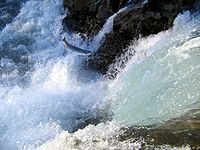
Photo from wikipedia
During spawning migrations, adult Pacific salmon ( Onco rhynchus spp.) must undergo a suite of morphological and physiological changes to prepare for spawning. Modern genomics approaches can be used to… Click to show full abstract
During spawning migrations, adult Pacific salmon ( Onco rhynchus spp.) must undergo a suite of morphological and physiological changes to prepare for spawning. Modern genomics approaches can be used to conduct nonlethal assessments of physiology and infectious agent presence in migrating salmon. We investigated gene expression changes and shifts in the prevalence and load of 18 infectious agents in the gill tissue of adult sockeye salmon ( Oncorhynchus nerka) during the final 50 km of their freshwater migration. We found 77% of fish successfully migrated to spawning grounds. Fish exhibited a decrease in thermal stress gene expression following lake migration, consistent with the hypothesized benefits of thermal refugia during spawning migrations. We also found evidence of cooler water selection (∼1.5 °C) during lake migration for fish with higher infection burden, suggesting behavioural changes for fish suffering higher infection burdens and potential benefits of thermal refuges for reducing the negative impacts of infection for migrating salmon. Collectively, our findings provide further evidence that fish behaviourally regulate exposure to stressful conditions such as high temperature that may undermine survival.
Journal Title: Canadian Journal of Fisheries and Aquatic Sciences
Year Published: 2023
Link to full text (if available)
Share on Social Media: Sign Up to like & get
recommendations!